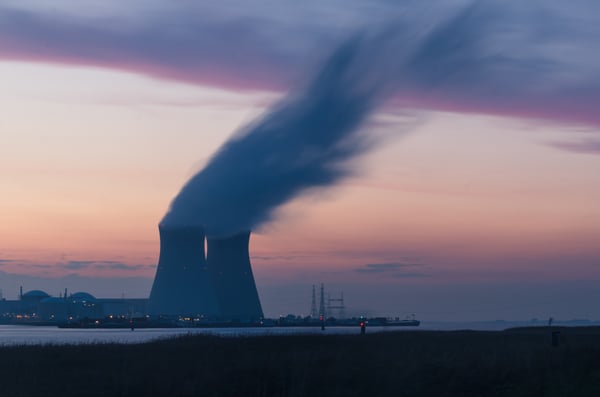It's a date we read about in our history books.
August 6, 1945.
On that day, a 10-foot-long bomb fell from the sky over Hiroshima, a city in Japan.
Not even a minute later, everything within a mile of where the bomb detonated ceased to exist.
An enormous firestorm quickly destroyed miles more, killing tens of thousands of people.
It was the first time an atomic bomb had ever been used in warfare.
What made it atomic? What was the element that was used to wreak all of that havoc?
It was uranium.
Uranium is unique because of one of its isotopes, uranium-235, if the only naturally occurring isotopes capable of sustaining a nuclear fission reaction.
Because of this, uranium has to pose several health risks, right?
Other than being turned into an atomic bomb, that is.
In the article below, we'll explore that question, and find out how dangerous uranium is.
Table Of Contents
- What Is Uranium?
- Applications Of Uranium
- Uranium In The Environment
- Health Effects Of Uranium
- Uranium And Radon
- Radon Is Just As Common As Uranium
What Is Uranium?
Uranium is a radioactive element that was discovered by a German chemist named Martin Klaproth in 1789.
Uranium has an atomic number of 92, which means that there are 92 protons in its nucleus.
Even though it's radioactive, it is surprisingly common in nature, being found in most of the rocks that make up the Earth's crust.
It's about as common as tin, and about 40 times more common than silver.
 Photo by Fredography’ https://fredography.be/
Photo by Fredography’ https://fredography.be/
Applications Of Uranium
Uranium became import with the development of practical uses of nuclear energy.
Depleted uranium is used as shielding to protect tanks, and it's also used in the construction of bullets and missiles.
The main use of uranium in the civilian sector is to fuel commercial nuclear power plants.
This requires the uranium to be enriched with the uranium-235 isotope and the chain reaction to be controlled so that the energy is released in a more manageable way.
Uranium In The Environment
Uranium is widely spread throughout the environment, making it impossible to avoid.
Uranium is found naturally in the environment in rocks, soil air, and water.
Humans can also add uranium metals and compounds to the environment through mining and milling processes.
The uranium concentrations in the air are very low.
Even at higher than usual concentrations in the air, there is no need to be worried about breathing in too much natural uranium.
When found in water, most of the uranium is dissolved that derived from rocks and soil that the water runs over.
Sometimes the uranium is suspended in the water, creating a muddy texture.
Only a very small part of uranium in water settles from the air. The amounts of uranium in drinking water are generally very low.
The Health Effects Of Uranium
We are constantly experiencing exposure to a certain amount of uranium that's naturally present in food, air, soil, and water.
Root vegetables and water provide us with small amounts of natural uranium, and we breathe in minimal concentrations of uranium in the air.
If you live near a hazardous waste site, mines, eat crops grown on contaminated soil, or drink water from a uranium waste disposal point will likely experience higher exposure than most people.
Uranium glazes are banned, but some artists will still use them for glass work.
They will obviously also experience a higher-than-usual exposure.
Due to its radioactivity, the health effects of uranium have been heavily researched.
Luckily, scientists have not detected any harmful radiation effects of natural levels of uranium.
However, chemical effects may occur after the uptake of large amounts of uranium and could cause health effects such as kidney disease.
If you're exposed to uranium radionuclides that are formed during radioactive decay for an extended period of time, there's a chance that you will develop cancer.
Your chances of getting cancer are much higher if you're exposed to enriched uranium because that's a more radioactive form of uranium.
That form of uranium gives off damaging radiation, which can cause people to develop cancer within just a few years.
Enriched uranium often ends up in the environment during accidents in nuclear power plants.
Uranium and Radon
Radon comes from the decay of Uranium.
Because uranium is radioactive, when it decays it becomes thorium, protactinium, radium, polonium, bismuth, and radon.
The EPA and the Surgeon General's Office have estimated that up to 20,000 lung cancer deaths are caused each year by radon.
This makes radon the second leading cause of lung cancer, right behind smoking.
Each year, radon costs the United States over $2 billion in direct and indirect health care costs.
So, other than when it's being used in an atomic bomb, uranium is perhaps most dangerous after it has decayed into radon.

Radon Is Just As Common As Uranium
Since radon comes from the decay of uranium, it's just as common in the environment as uranium.
Radon is invisible, tasteless, and odorless. You could be breathing in toxic amounts of radon without even knowing it.
It's impossible to detect radon using only our senses. And, since it's the second leading cause of lung cancer, you absolutely need to know if you're breathing in toxic levels.
The best way to find out is to leave it to the experts.
The professionals at Radon Eliminator have years of experience and expertise when it comes to testing homes for elevated levels of radon.
To be sure you and your family are safe from radon, click the button below. There's no time to waste.





